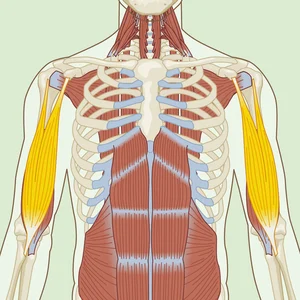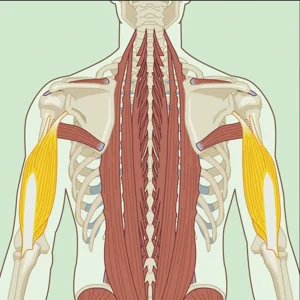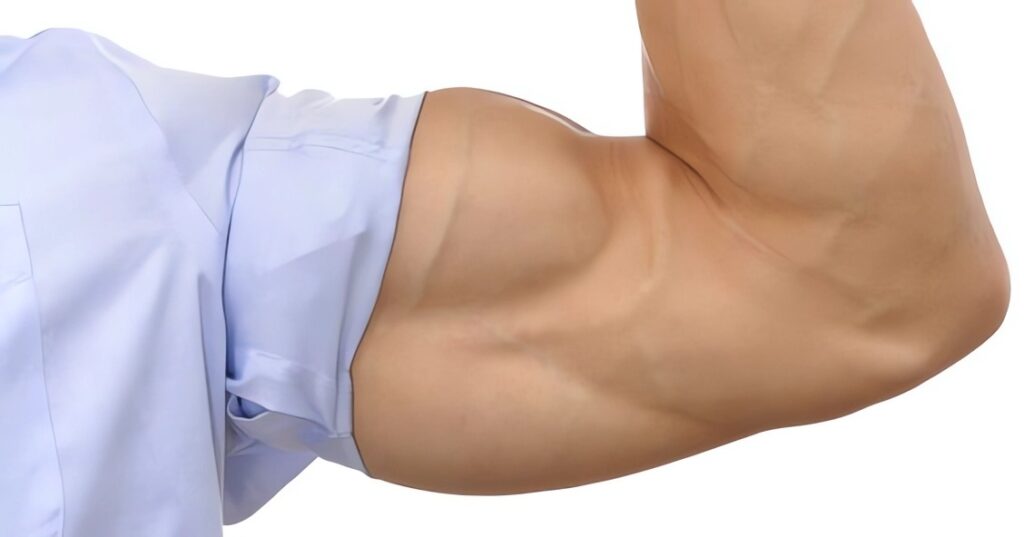Are you searching for more robust, well-defined arms to display proudly?
If you aspire to have toned and sculpted arms, these arm exercises focused on strength training are worth trying.
If you have a genuine passion for sculpting arms, consider imparting your knowledge through the perspective of exercise science with Best personal trainer Toronto.
Start your journey to becoming a personal trainer online today!
Table of Contents
- Anatomy Review
- Arm Workout Tips
- Barbell Biceps Curl
- Cable Tricep Extension
- Hammer Curls
- Bench Dumbbell Tricep Extensions
- Cable Bicep Curls With Shoulder Flexed
- Cable Tricep Extensions With Shoulder Flexed
- Wrist Flexion
- Wrist Extension
- Wrist Supination/Pronation
ARM MUSCLE ANATOMY REVIEW
Before delving into the exercises, let’s briefly go over the anatomy of the arm. Understanding the muscles targeted in each activity is essential. The following overview covers some major arm muscles and their functions, although it could be more comprehensive.
BICEPS BRACHII

Location: The biceps brachii, commonly known as the biceps, are situated at the front of your upper arm, between the elbow and shoulder. The biceps have two distinct “heads” or muscle bellies: short and long heads, each with different attachment sites.
Function: The biceps facilitate elbow flexion (bending your arm at the elbow), supination (rotating your hand from a palm-down to a palm-up position), and shoulder flexion (raising your arm in front of your body).
Example Exercises: Dumbbell/barbell biceps curls, hammer curls, preacher curls.
TRICEPS BRACHII

Location: The triceps brachii, referred to as the triceps, are positioned at the back part of your upper arm, between the elbow and shoulder. The triceps consist of three distinct “heads”: a short head, a medial head, and a long head, each with different attachment sites.
Function: The triceps facilitate elbow extension (straightening your arm at the elbow) and shoulder extension (moving your arm towards your backside—the opposite of shoulder flexion).
Example Exercises: Triceps pushdowns, narrow-grip bench press, narrow-grip push-ups, triceps kickbacks, supine triceps extensions (skull crushers).
BRACHIORADIALIS

Location: The brachioradialis is a primary muscle on your forearm’s lateral (thumb-side). It attaches slightly above the elbow on your humerus (upper arm bone) and near your wrist.
Function: The brachioradialis aids elbow flexion and assists with supination and pronation of your forearm (rotating your hand from a palm-down to a palm-up position and vice versa).
Example Exercises: Hammer curls, reverse curls, preacher curls.
BRACHIALIS

Location: The brachialis lies beneath the biceps brachii on the anterior part of your arm. It attaches slightly above the elbow on your humerus and below your elbow on your ulna (one of your two forearm bones).
Function: The brachialis facilitates elbow flexion.
Example Exercises: Dumbbell/barbell biceps curls, hammer curls, preacher curls.
ARM WORKOUT: TIPS, SETS AND REPS
When engaging in arm training, it is vital to remember that your arms are comprised of numerous muscles, which interact with various joints, including the wrist, elbow, and shoulder.
Incorporating a diverse range of movements at each joint is essential to adequately stress the muscles to ensure a comprehensive workout routine.
Consequently, your exercises should target both your arms’ upper and lower parts. This approach will aid in sculpting your arms, providing the desired shape and definition while also granting you the strength required for everyday tasks such as opening a jar or lifting a heavy object.
The exercises listed are designed to be performed with moderate loads and repetitions, emphasizing muscular hypertrophy (muscle growth) and muscular endurance. As your fitness and strength progress, you can increase the load and volume (sets, reps).
It is crucial to perform each set until muscular fatigue is reached. In simpler terms, the last few repetitions should pose a challenge, but maintaining ideal form, posture, and technique throughout the entire set is essential.
Lastly, the arm exercises provided are mere examples. Feel free to swap them out with your preferred exercises and methods, whether using machines, dumbbells, kettlebells, elastic tubing, or body-weight suspension trainers.
Key Takeaways:
- Incorporate a variety of movements at each joint.
- Focus on both the upper and lower arms.
- Opt for exercises with moderate loads, sets, and reps.
- Aim to push each set to muscular fatigue.
- Customize the exercises to your liking using your preferred movements and equipment.
BEST ARM EXERCISES
- BARBELL BICEPS CURLS
Preparation
- Begin by standing and holding a barbell with both hands.
Movement
- Initiate the barbell curl by flexing both elbows while retracting your shoulder blades.
- Curl the barbell upward, aiming for chest level. Maintain a neutral spine and avoid arching your lower back.
- Slowly return the barbell to its original position by extending your elbows.
Safety
Avoid gripping the barbell too closely or too broad to reduce strain on your elbows. Determine the grip width by extending your elbows until your hands naturally align with your sides, with palms facing forward. The position where your hands naturally fall is the ideal grip width for holding the barbell.
Complete 3-5 sets with 6-12 repetitions in each set.
2. CABLE TRICEPS EXTENSION
Preparation
- Sit upright, maintaining a shoulder-width stance with your feet pointing straight ahead.
- Hold two cable handles, keeping your elbows flexed.
- Ensure your shoulder blades are retracted and held down.
Movement
- Push your hands downward until your arms are fully extended. Maintain a position where your shoulders do not rise towards your ears during the movement.
- Hold this position briefly.
- Slowly return to the initial starting position.
Technique
Utilizing a cable attachment for cable pushdowns allows for a more natural path of motion for your elbows compared to a fixed hand position on a bar. This modification can reduce stress on your elbows.
Complete 3-5 sets with 6-12 repetitions in each set.
3. DUMBBELL HAMMER CURLS
Preparation
- Stand with your feet flat on the floor, facing forward.
- Hold a dumbbell in each hand, allowing your arms to hang by your sides with your palms facing each other.
Movement
- Initiate a hammer curl by flexing your elbows while maintaining the palm-to-palm orientation.
- Ensure your shoulder blades remain retracted during the curl.
- Gradually bring the dumbbells back to their starting position.
Do 3-5 sets, 6-12 repetitions
4. BENCH DUMBBELL TRICEPS EXTENSIONS
Preparation
- Lie down on a flat bench.
- Keep your feet flat on the ground with toes pointing forward.
- Hold a dumbbell in each hand with your elbows bent.
Movement
- Extend your elbows until your arms are fully straightened.
- Hold this position momentarily.
- Gradually lower each dumbbell towards your forehead by flexing your elbows, ensuring your lower back maintains a neutral position without excessive arching off the bench.
- Repeat the movement.
Safety
For reduced joint stress on your elbows, maintain a shoulder-width grip.
Complete 3-5 sets with 6-12 repetitions in each set.
5. CABLE BICEPS CURLS WITH SHOULDER FLEXION
Preparation
- Stand and grip a cable attachment handle while flexing your shoulder.
Movement
- Initiate a biceps curl by flexing your elbow, ensuring your shoulder blade remains retracted.
- Continue the curl until your elbow is fully flexed.
- Slowly return to the starting position by extending your elbows.
Complete 3-5 sets with 6-12 repetitions in each set.
6. CABLE TRICEPS EXTENSION WITH SHOULDER FLEXION
Preparation
- Stand and hold a cable attachment handle (facing away from the machine) with your shoulder flexed.
Movement
- Execute a triceps extension by straightening your elbow until your arm is fully extended.
- Focus the movement solely on the elbow, avoiding any flexion or extension of your shoulder.
- Gradually return to the initial position by flexing your elbow.
Complete 3-5 sets with 6-12 repetitions in each set.
7. WRIST FLEXION
Preparation
- Sit on a bench or stability ball, ensuring one arm is comfortably placed on a table or a sturdy surface.
- Hold a light dumbbell with your palm facing upwards, allowing it to hang slightly off the table.
Movement
- Execute a wrist flexion through a comfortable range of motion.
- Maintain this position briefly.
- Slowly revert to the initial starting position.
Complete 3-5 sets with 6-12 repetitions in each set.
8. WRIST EXTENSION
Preparation
- Sit on a bench or stability ball, ensuring one arm is comfortably placed on a table or a sturdy surface.
- Hold a light dumbbell with your palm facing downwards, allowing it to hang slightly off the table.
Movement
- Execute wrist extension through a comfortable range of motion.
- Maintain this position briefly.
- Slowly revert to the initial starting position.
Complete 3-5 sets with 6-12 repetitions in each set.
9. WRIST SUPINATION/PRONATION
Preparation
- Sit on a bench or stability ball, ensuring one arm is comfortably placed on a table or a sturdy surface.
- Hold a lightweight object with your palm facing upwards, allowing it to hang slightly off the table.
Movement
- Initiate wrist pronation by rotating your lower arm from a palm-up to a palm-down position.
- Reverse the movement to execute wrist supination.
Complete 3-5 sets with 6-12 repetitions in each set.

